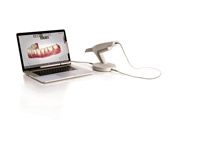How to scan with ease and simplicity
Our office recently purchased a TRIOS Scanner by 3Shape. We also recently began using ClearCorrect as our lab for clear aligners, as it accepts TRIOS scans for use with its clear aligners. We have found the use of our 3Shape TRIOS scanner with the ClearCorrect system to be both convenient and intuitive in our office.
Our office recently purchased a TRIOS Scanner by 3Shape. We also recently began using ClearCorrect as our lab for clear aligners, as it accepts TRIOS scans for use with its clear aligners. We have found the use of our 3Shape TRIOS scanner with the ClearCorrect system to be both convenient and intuitive in our office.

The first ClearCorrect case we chose to use the 3Shape scans for was selected for ease and simplicity: A 15- year-old girl with mild orthodontic relapse caused by poor retainer compliance. One of our dental assistants did all of the scanning in mere minutes, which was great considering this was our first full-arch scanning attempt and also included capturing the patient’s bite. Since then, the scanning time has been reduced even further.
Taking impressions digitally is different than (and superior to) traditional VPS impressions, primarily in that there are no second impressions needed if the first is found to have a defect. You can always go back into the digital file and make any edits needed. Therefore, there is no added cost for further impression material. Also, scanning does not leave bubbles or defects at critical margin areas as is quite common with traditional VPS impressions. If an area needs a little more definition, simply rescan that area and, in seconds, a repaired image is provided.
Additionally, patients have mentioned they prefer the scanning process over having the “goop” of VPS impressions in their mouth; thus, we have no instances of gagging while utilizing the scanner.
Another advantage with scanning involves decreased turnaround times. Once the scan has been submitted to ClearCorrect, the lab sends a message that it has been received and accepted. Therefore, the scan file cannot be lost in the mail, and, if for some reason the scan file disappears into the Internet, it is simple to resend it to the lab in mere seconds. In addition, you don’t have to wait for the impression to arrive to the lab in the mail. All of these things make the turnaround time much more predictable than with traditional VPS impressions, allowing treatment to continue quickly.
The scanning process is simple: The dental assistant begins the scan by scanning the lower arch-first the occlusal and then the lingual and buccal surfaces. Next, the upper arch is scanned, beginning with the occlusal and following with the buccal and lingual surfaces of the arch. If the scan includes images of cheek, tongue or glove pieces, it is easy to trim and remove the unwanted images using the trim function within the TRIOS software.
After the scan is complete and trimmed, the images are evaluated for completeness and detail. It is easy to detect missing aspects of the teeth or gingival margins, and any missing information can be added to the scan in seconds. After evaluating the full-arch scans, bite images are taken. The patient is asked to close teeth together, and the scan is performed from the distal forward. When enough of each arch is recognized, the software merges the arches into a new image, virtually duplicating the patient’s bite.
During our office’s training session (when the TRIOS unit was initially set up in our office), we created links to all of our participating labs, including ClearCorrect. This allows us to send the scans to ClearCorrect simply by pressing a button on the TRIOS unit. After ClearCorrect received this particular patient’s scans, the case was staged and a treatment setup was sent to our office for approval the very next day. A next-day turnaround would be impossible with traditional VPS impressions, and the patient was happy to begin his or her treatment more quickly thanks to the 3Shape TRIOS scanner and the ClearCorrect lab.
About the author James C. Vogler, DDS, is a general dentist in Dansville N.Y., a rural town in upstate New York. Jim graduated from SUNY Buffalo in 1990. He is a fellow in the Academy of General Dentistry and a member of the Seattle Study Club of Rochester. He is married to Jody and has three boys, Jon, Nick and Andrew.
ACTIVA BioACTIVE Bulk Flow Marks Pulpdent’s First Major Product Release in 4 Years
December 12th 2024Next-generation bulk-fill dental restorative raises the standard of care for bulk-fill procedures by providing natural remineralization support, while also overcoming current bulk-fill limitations.